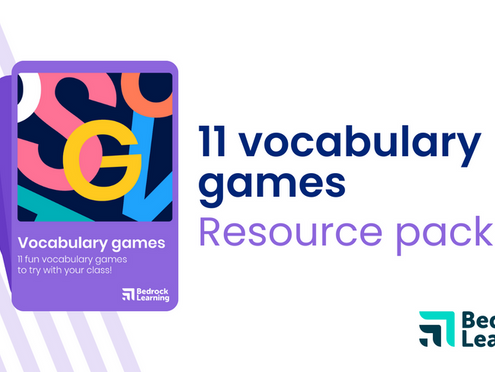When we hear a word we know, we instinctively relate it to an object or concept we’ve experienced in the world - but we weren’t born with this skill. We didn’t always connect ‘happiness’ with the emotion we feel when we’re in a good mood. We had to learn to make that connection. Without learning that connection, ‘happiness’ would still be a strange sound and a row of letters.
That’s why it’s so tough being a teacher of vocabulary. It’s our job to transform gobbledegook into something with a clear and specific meaning.
With such a huge task in hand, it’s understandable that a lot of us make some common mistakes when trying to introduce a vocabulary curriculum to our schools. Here’s three we’ve seen quite a lot over the years, with explanations for why they don’t qualify as best practice.
3 common mistakes teachers make when introducing a vocabulary curriculum
1. Relying on chance
Effective vocabulary instruction should be as proactive as possible. Nevertheless, it is quite common for the teaching of new words to become a passive affair in the classroom.
Rather than deliberately creating opportunities to teach exciting, academic vocabulary to their class, many teachers rely too heavily on waiting for learners to encounter challenging and unfamiliar words in textbooks or classroom discussions - in other words, encounter ambitious vocabulary by chance.
Of course, I’m not saying we shouldn’t respond to serendipitous teaching opportunities. The ability to identify and react to these moments is a sign of conscientious teaching. But what about all the moments that don’t arise? What about the learners who silently struggle, too self-conscious to bring it up in class?
To help these learners, we need to be ahead of the curve. Leaving vocabulary teaching entirely to chance will never be enough to ensure that our classes are learning – and, most importantly, retaining – a large range of new words. As Robert Marzano says, students need to be exposed to a new word at least six times before they can remember and comprehend it.
For this reason, an effective vocabulary curriculum must follow a consistent strategy which provides learners with multiple opportunities to learn, practise and review new words.
2. The "check the dictionary" approach
Dictionaries are extremely handy, there’s no denying that. When a learner comes to you with a word they don’t understand, it seems so convenient to give them a dictionary and ask them to browse for a definition. And for teachers who are trying to avoid mistake number one, challenging learners to repeat and memorise definitions seems like the simplest way of ensuring active teaching of words.
Alas, dictionary definitions aren’t quite as helpful as they seem - the problem with dictionaries is that they only provide you with a limited perspective on a word.
For one thing, definitions are rarely written in language that all students can understand. If an unfamiliar word is defined using more tricky Tier 2 language, it is unlikely to be of much use to learners who already struggle with their literacy skills.
Beyond this, however, is the fact that dictionaries are limited in showing how words can be used in different contexts – especially in contexts that are relevant to learners' life experiences. As research has shown, simple memorisation and repetition of dictionary definitions is unlikely to equip learners with a nuanced understanding of the word. Instead, learners should be provided with detailed explanations which showcase how the word can be used in appropriate example sentences.
3. Relying solely on reading
I love reading. It’s my favourite thing to do. There’s no doubt that setting dedicated reading time is beneficial for our learners; it introduces them to new perspectives, and provides them with space for intellectual and emotional introspection.
However, many teachers believe that simply by asking their learners to read for ten, twenty or thirty minutes, this will be enough to ensure they experience the vocabulary growth they need.
If only it were that simple…
Unfortunately, reading by itself does not constitute as an effective vocabulary curriculum. This is because many texts can be challenging, full of lots of words that learners may never have encountered before. If learners are then unable to intuit the meanings of these words from context, it is unlikely they will be able to comprehend the text fully and reap all the benefits reading can offer.
To ensure that learners have the necessary literacy skills to access these tricky texts, it is important to have a direct and specific focus on teaching new vocabulary. But, of course, it’s always good to make sure your learners are reading too.




